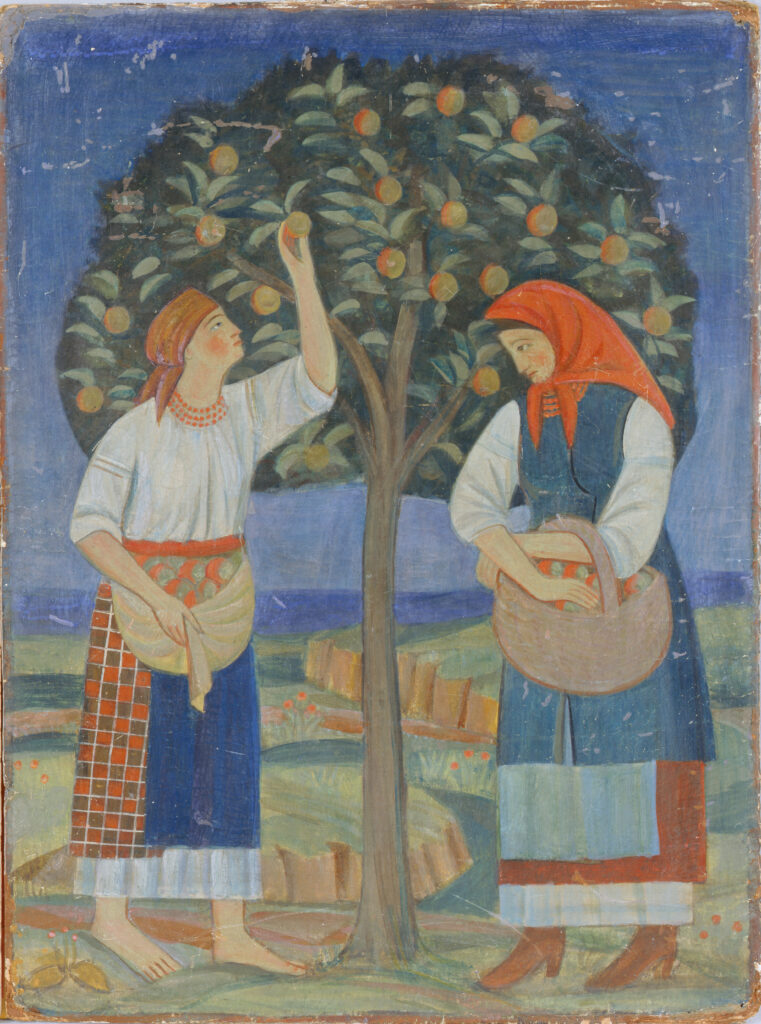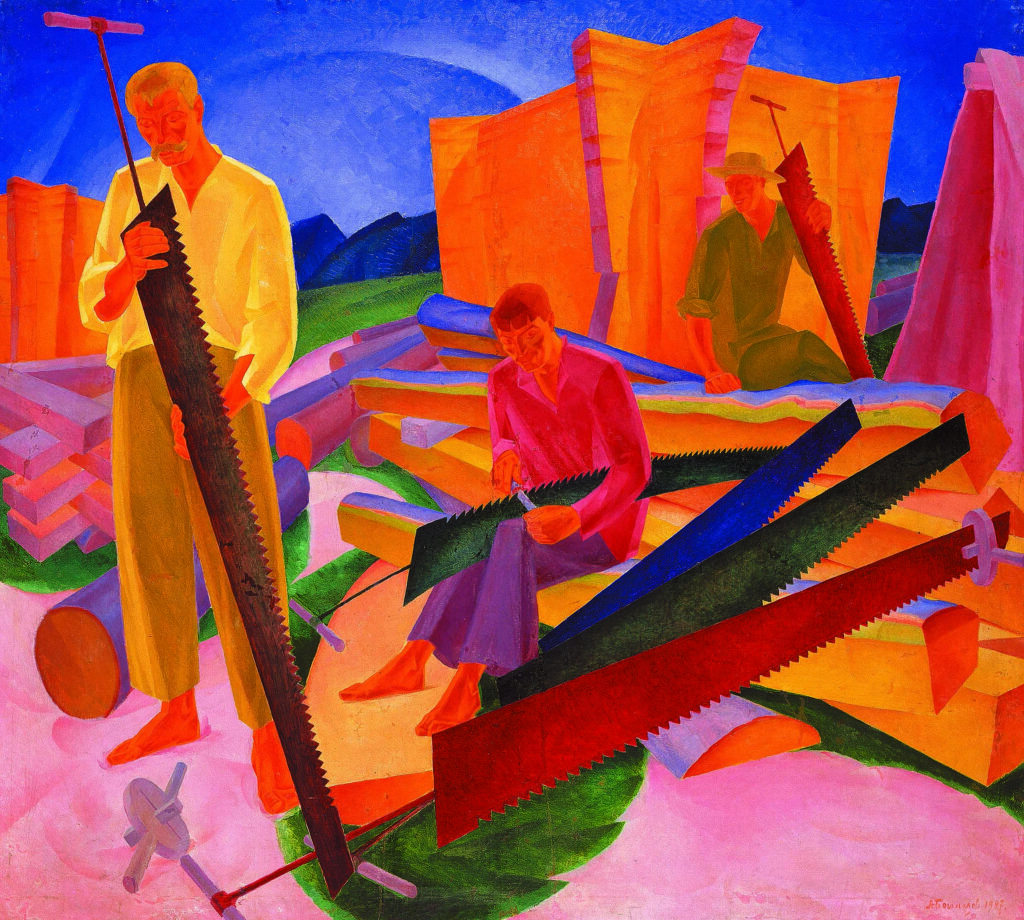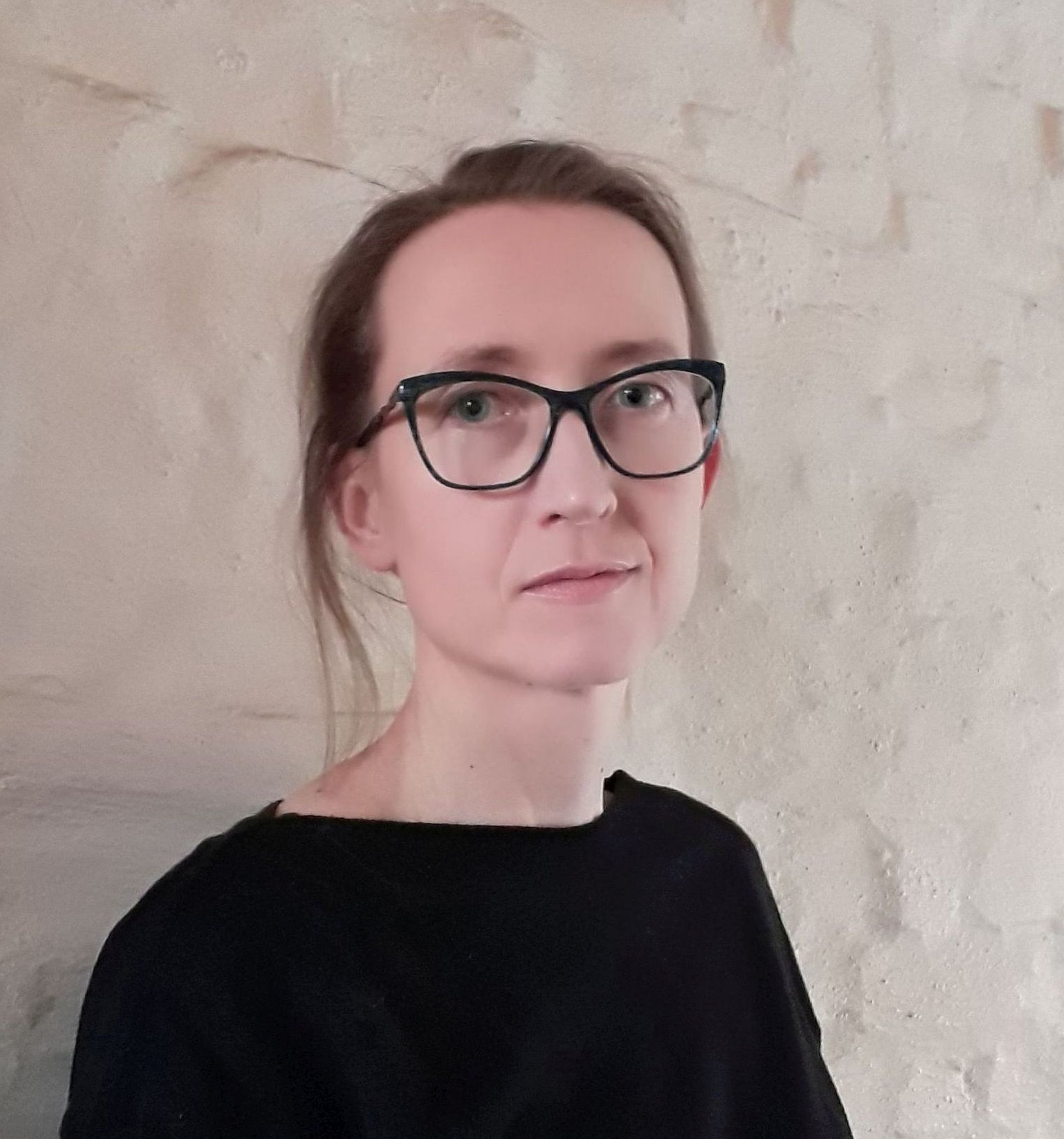Vernacular Modernisms, or Art in Spite of All
IN THE EYE OF THE STORM: MODERNISM IN UKRAINE, 1900-1930S, THYSSEN-BORNEMISZA NATIONAL MUSEUM, MADRID, SPAIN; MUSEUM LUDWIG, COLOGNE; THE ROYAL MUSEUMS OF FINE ARTS OF BELGIUM, BRUSSELS; THE BELVEDERE, VIENNA; THE ROYAL ACADEMY OF ARTS, LONDON; NOVEMBER 29, 2022-MAY 2, 2023
Visiting a modern art exhibition from Ukraine at this critical juncture is an uncanny experience. The modernist undertaking of the early twentieth century vividly demonstrates parallels between Ukraine’s historical quest for independence and the country’s current resistance against Russian aggression, which began in 2014 and escalated into a full-scale war in 2022. In the Eye of the Storm, the exhibition’s evocative title, captures the continuous menace that haunted the pioneering Ukrainian artists and intellectuals as they endeavored to carve out their own space and artistic language. The struggle was not lost—this is evident in the remarkable collection of modern art assembled for this show. Notably, the event is also an opportunity to look critically at established narratives of modern art.
The exhibition was conceived under exceptionally challenging circumstances. A significant number of artworks were urgently evacuated from Kyiv amidst the intensifying war. Curators Konstantin Akinsha, Katia Denysova, and Olena Kashuba-Volvach had been developing the idea for it for some time; however, the February 2022 invasion of Ukraine by Russia accelerated the process, culminating in the exhibition’s completion in under a year—an impressive feat. Despite the time constraints, the curators succeeded in producing a comprehensive catalogue that not only contextualizes the exhibition but also includes pieces that, due to the current conditions, could not physically be part of the display.
The exhibition has had an impressive itinerary—it has toured several prestigious European venues, starting at Museo Nacional Thyssen-Bornemisza in Madrid, continuing to Museum Ludwig in Cologne, the Royal Museums of Fine Arts of Belgium in Brussels, the Belvedere in Vienna, and culminating at the Royal Academy of Arts in London.(This review is mainly based on the Brussels iteration of the show co-curated by Francisca Vandepitte.) At each location, the exhibition’s scope was subtly adapted, with some works featured exclusively at one or two venues. Nonetheless, its core remained unchanged, stemming from the collections of two major Kyiv institutions, the National Art Museum of Ukraine (NAMU) and the Museum of Theatre, Music and Cinema of Ukraine. This focus emphasizes Kyiv, Kharkiv, and Odessa as pivotal artistic centers and highlights theater design as a significant extension of modernist ideas beyond the white cube.
The show is organized into eight well-thought-out thematic sections that are roughly chronological but shift the focus between stylistic developments, art organizations and schools, as well as significant events. The starting point is the section “Cubo-Futurism”—the dominating style in the early 1910s—followed by a section on the Jewish organization “Kultur Lige (Culture League).” Next is the “Theater Design” section, which showcases little known drawings and watercolor sketches. It is followed by the section “Kharkiv” as the cultural hub in the 1920s and “The Boichukists” as one of the most significant local schools of art associated with Mikhailo and Tymofii Boichuk. The subsequent section, “Venice Biennale,” zooms in on the participation of Ukrainian artists in that international exhibition. Closing the narration are the “Kyiv Art Institute” section and the final one titled “The Last Generation.” The curatorial approach embraces the complexity of the artistic and cultural developments of the time. The shifting emphasis in each section is a deliberate attempt to reshuffle the existing debates on modernism’s decolonization and decanonization, moving beyond Western-centered perspectives, while at the same time undermining the still nationalistically dominated art historical discourse. This becomes clear in the three opening sections.
Cubo-Futurism was a loose movement of artists, often educated in major European centers such as Paris, Munich or Cracow, and inspired by the avant-garde currents of futurism and cubism. Alexandra Exter and Davyd Burliuk are prime examples of artists who, after spending time in various cities around Europe, settled in Kyiv. The Białystok-born Alexandra Exter was a particularly versatile artist who was acquainted with Picasso and Braque in Paris but returned to Ukraine where she contributed to the Verbovka workshop of embroidery and textiles alongside Kazymyr Malevych.(Editors’ note: In this review, the author has used the spellings of artists’ names used by the curators in the exhibition, which are sometimes different from their more common renderings in English.)The exhibition showcases her brightly colored Three Female Figures, painted in a bold, flattened perspective with simplified, almost geometric shapes. Even more revealing are her works for the textile and embroidery workshop, reproduced and discussed in the catalogue, which demonstrate how she crafted a unique mixture of international trends and local traditions. This is one of the key insights of In the Eye of the Storm—that the art made in Ukraine during the modern period was a fascinating amalgam of the vernacular and larger European trends.

Alexandra Exter, Three Female Figures, 1909-10. Oil on canvas, 63 x 60 cm. National Art Museum of Ukraine.
Following these international beginnings, the second section of the exhibition on Kultur Lige highlights the diversity within local arts circles. Kultur Lige, a Jewish organization founded in 1918 in Kyiv, aimed to promote Yiddish language and culture. Its art section brought together artists like Issakhar Ber Ryback, Sarah Shor, and Marko Epshtein, who merged modern visual language with distinctly Jewish motifs and themes. Some, like Shor, developed an almost abstract, geometric style, while others included recognizable elements like clothing and stetl landscapes into their canvases. The show features the painting Composition (1918-1920) by El Lissitzky, who was active in Kyiv during the period. The piece is a characteristically Suprematist composition of planes, geometric shapes and lines. Unlike his mentor Kazymyr Malevych, El Lissitzky’s approach to abstraction emphasizes the depth of plane and the three-dimensionality of geometric forms. A closer inspection of the painting, possible only when seeing it face-to-face in the show, reveals a tiny, collaged text in Yiddish at its center. The seemingly abstract visual language of the avant-garde subtly anchors itself in the cultural and linguistic reality of early twentieth century Ukraine, where Ukrainian, Jewish, Polish, Russian, Greek, and other cultures coexisted and transformed the artistic scene of the time.
The third section on theater design shifts the focus toward performative arts and demonstrates how modern artists transformed scenography and costume design along the lines of avant-garde aesthetics. This section features drawings and watercolor paintings by artists already highlighted in other parts of the exhibition, such as Exter and Anatol Petrytskyi (who will be mentioned below), illustrating the cross-media spread of artistic ideas. Additionally, it presents works by artists more deeply involved in stage design, including Vadym Meller and Oleksandr Khvostenko-Khvostov. Meller’s watercolor costume designs are marked by a cubist approach, evident in the geometric rendering of shapes and lines. In contrast, Khvostenko-Khvostov’s designs are rhythmic and lean towards constructivist aesthetics, with both artists experimenting with bright and often contrasting colors. Meller, born in Saint Petersburg, studied in Kyiv and Munich, and spent time in Paris before returning to Ukraine. He collaborated extensively with choreographer Bronislava Nijinska, the Taras Shevchenko Theatre and later the Berezil Theatre in Kyiv and Kharkiv. Khvostenko-Khvostov, born in Borisovka near Kharkiv (now part of Russia) studied in Moscow and Kyiv before eventually settling in Kharkiv. These and other artists active in stage design predominantly worked in the two artistic centers Kyiv and Kharkiv, confirming the significance of these cities as the focal points of the exhibition.
What falls out of the scope of this exhibition is the Western part of Ukraine historically known as Halychyna or Galicia, most likely due to its detachment from the rest of Ukraine during the period of 1900-1930. Galicia, once part of the Austro-Hungarian empire until 1918 and later incorporated into the Second Polish Republic until 1945, is still present indirectly. For example, one of the leading artists Olexandr Bohomazov, who had his roots in the region, infused his art with elements of Galician culture. Yet the choice of Kyiv, Kharkiv, and Odessa as the focal points for the exhibition is a poignant reminder of the extent to which the developments in art were intertwined with the political upheavals and continuous external pressures faced by the Ukrainian people.
Until 1905, Ukraine’s inclusion in the Russian empire led to an unrelenting suppression of the Ukrainian language and culture. The revolution of 1917 briefly paved the way for the country’s independence before its incorporation into the Soviet Union as one of its republics. The short period of independence sparked a revival of theater, printing, education and press in Ukrainian, until the Soviet rule reimposed central policies on national cultures. At first, the Soviet authorities allowed vernacular languages and cultures to thrive—this became known as the indigenization policy or korennizatiia. In the Ukrainian Soviet Republic, it took shape as Ukraininzation or Ukrainnizatziia. From today’s perspective this was an ambiguous phase—on the one hand, Ukraine was subsumed under the Soviet rule which in many respects continued the imperial ambitions of the Russian Empire. On the other hand, it allowed for limited emancipatory tendencies. The language and culture were not forbidden for a short but crucial period in Ukrainian history, crystallizing along the lines of more internationally oriented modernism. The short-lived liberal policy towards the vernacular became decisive despite the backlash that followed.
In the 1930s, the harshening of the Soviet policies led to unprecedented censorship and repression in Ukraine. Many artists featured in the show were banned, lost commissions, were sentenced, imprisoned, and in some cases executed. Soviet authorities often accused them of dangerous formalism and reactionary nationalism. Formalism, in this context, referred to anything avant-garde that did not conform to the then-accepted style of socialist realism. The accusation of reactionary nationalism specifically targeted all expressions of intrinsically Ukrainian culture, confirming its distinctness from the Russian core of Soviet culture. Many major works of art were hidden away in a secret collection called Spetsfond (Special Collection) as they were deemed to contain one or both of these qualities. They remained hidden for many decades and paradoxically, it is this ideological ostracism allowed them to survive until now.(Yuliia Lytvynets, “From Oblivion to Glory. Spetsfond or The Special Secret Holding,” in Akinsha, Konstantin, Katia Denysova, and Olena Kashuba-Volvach, eds., In the Eye of the Storm: Modernism in Ukraine, 1900-1930s. (London: Thames & Hudson, 2022), p. 115.)
Amidst this particularly somber historical backdrop, the exhibition accomplishes two significant feats. Firstly, it showcases lesser known or entirely forgotten artists, demonstrating their outstanding contributions to the global histories of modernism. Secondly, it situates some well-known artists within the orbit of specifically Ukrainian art and culture, despite their previous identification as representatives of the so-called “Russian” avant-garde. At the same time, the exhibition avoids simplifications and tempting reversals of the still-dominant Russia-centered narrative, even given the tragic context in which it had to come into being. Several world-class museums have recently adjusted their policies, updating inventory entries and gallery information for artists previously identified as Russian but now recognized as Ukrainian. In some cases, this is a straightforward and necessary corrective to mainstream art history. However, the historical context is often far less clear. A prime example is Kazymyr Malevych, the inventor of Suprematism, who was brought up in Ukraine in a Polish family, though he was later educated in Russia—unsurprisingly so, considering that Ukraine was not allowed to have its own art school. The exhibition includes a small scenography sketch by Malevych, reminding visitors of the significant Ukrainian episode in his artistic trajectory. However, there is no attempt to reclaim Malevych exclusively for Ukrainian art history. Such an approach would merely reverse the strategy of imperial Russia, which appropriated the diverse cultures colonized by the Russian Empire and the Soviet Union as its own.
Instead, In The Eye of The Storm opens the intricate field of cultural multiplicity and complexity. It focuses not solely on the Ukrainian aspects of the art of the period but on the diverse, rich cultures coexisting in Ukraine. Malevych undoubtedly absorbed many elements of local traditions and landscapes into his art and contributed significantly to the local art scene. He left for Moscow, Vitebsk and Leningrad to advance his artistic career but interestingly returned to teach at the Kyiv Institute of Art in 1928-1930 where avant-garde was still accepted.(Konstantin Akinsha, “Introduction,” in Akinsha, In the Eye of the Storm, p.10.) He also published a series of theoretical essays in Nova heneratsiia (New Generation), which was a literary artistic monthly established in Kharkiv in that period.(Myroslava M. Mudrak, “Nova heneratsiia (1927-1930),” in Akinsha, In the Eye of the Storm, p.82.) The curtailing of artistic freedom by the Soviets proceeded at different paces and intensities in various republics. Differentiating between these local contexts allows for a fuller picture of this fascinating and tumultuous history.
The exhibition skillfully interweaves more recognizable episodes of global art history with locally known names and schools, demonstrating that the established ideology of modernism as a universal visual language of pure forms, devoid of particularisms, is misleading. The forced or voluntary movement of artists and the volatility of artistic trends resulted in a multiplicity of what might be called ‘vernacular’ modernisms. Other sections of the exhibition, focusing on centers such as Kharkiv and artistic movements like Boichukism, illustrate this well. The watercolor paintings by Maria Syniakova, an artist from the Kharkiv circles, are marked by primitivist stylistics. Her colorful, figurative compositions, painted with child-like simplicity and populated by flowers, animals, and people, bridge folk art and modernist experimentation. In contrast, Anatol Petrytskyi’s more realist painting, Radiator (1926), has a snapshot quality, with the head of a woman visible in the bottom right corner while the center of the painting is dominated by an almost empty table and an unusually large radiator. The typographic designs and paintings by Vasyl Yermilov, another prominent figure of the Kharkiv school, are bold and simple, balancing between abstraction and figuration.
In stark contrast to the Kharkiv experiments in form is the school of artists known as Boichukists named after brothers Mikhailo and Tymofii Boichuk, active at the Ukrainian State Academy of Arts in Kyiv. Boichuks and their followers consciously attempted to revive local religious traditions of Byzantine art, icon painting and folk culture. This resulted in figurative works recognizable by their simplified forms, rhythmic compositions and vernacular themes, predominantly relating to peasant life. The school had a large following and produced many works in public spaces. Most of these monumental paintings and frescoes were destroyed as Soviet policy harshened and turned against what was perceived as typically Ukrainian.

Tymofii Boichuk, Women under the Apple Tree, 1920. Tempera on cardboard, 54 x 40 cm. National Art Museum of Ukraine.
The necessity of constantly reaffirming the country’s existence is—unsurprisingly— a common theme running through the show, influencing the selection of topics. This explains why a whole section is devoted to Ukrainian participation in the Venice Biennale of 1928 and 1930. In these two editions, Ukraine was invited to present its art in a separate, dedicated section of the Soviet pavilion. It was the only republic of the Soviet Union to gain such unprecedented visibility on the international art scene. It remains unclear why Soviet authorities gave prominence to Ukrainian artists in this important international showcase of Soviet art.(Olena Kashuba-Volvach & Maryna Drobotiuk, ”In the Shadow of Russia. Ukrainian Art at the XVI Venice Biennale of 1928,” in Akinsha, In the Eye of the Storm, pp.100-101.) What is certain is that international art critics noted the distinctness of the Ukrainian contribution compared to the overly propagandistic art of other Soviet artists. Highlighting this episode, the curators indicate that even during Soviet rule, the unique character of Ukrainian modernist art gained recognition beyond the local context. The sizable painting by Anatol Petrytskyi, entitled The Invalids, dominated by large, sad human figures with visible disabilities, painted in grey and brown hues, distinguishes itself against the overly optimistic Socialist Realist art. In contrast, Bohomazov’s electrifyingly colorful yet rigorously geometrical painting Sharpening the Saws, included in the Kyiv Art Institute section of the exhibition and also shown in Venice in 1930, is yet another compelling iteration of modern ideas combined with local themes.

Oleksandr Bohomazov, Sharpening the Saws, 1927. Oil on canvas, 138 x 155 cm. National Art Museum of Ukraine.
Although relatively modest in size, the exhibition offers invaluable insights into a crucial period, revealing a vibrant yet little-known art scene. It underscores the need for more research and exhibitions to fully explore this newly engendered artistic heritage. For instance, works in media other than painting and drawing could have been better represented. It would have been particularly interesting to see photography and film from the period. More space and international attention are required to build on this endeavor by Ukrainian scholars who, against all odds, spared no effort to patiently reframe the histories of modern art of the region. As writer Andrei Kurkov noted, the current assault on Ukrainian culture will likely have the opposite effect of what is intended. Instead of eradicating it, it will make it stronger.(Andrey Kurkov, “10.04.2023. The Long Path to Self-Identification,” in Our Daily War (London: Orenda Books 2024)) In the Eye of the Storm gives historical depth to that remark, yet importantly, avoids oversimplified reversals of the still-dominant narratives on Soviet art. It uncovers the many complex entanglements between local and international trends of the time, including the intricate connections between Ukrainian and Russian histories. The show provides a much-needed reminder of the particularly harsh circumstances in which modern artists lived and worked in Ukraine. At the same time, it does not shy away from the many ambiguities of that history, highlighting the sometimes contradictory effects that changing political forces had on art and artists.




